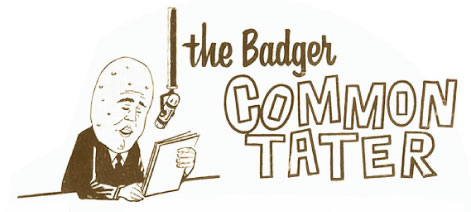In the July 2013 Badger Common’Tater
The Badger Beat
Insect Pressure: What a Difference a Year Makes
By Dr. Russell L. Groves, University of Wisconsin, Department of Entomology
How quickly things can change. Earlier this year (January 2013, Badger Common’Tater), I wrote about the weather of 2012 and its direct influence on insect populations. Specifically we noted how the very hot and dry weather conditions that prevailed last year had a significant influence on the type of insects that increased to damaging levels, the size of their populations, and the long-distance migrants that arrived en masse from southern locations. As we discussed, these density-independent factors (weather) were especially important in driving populations of several of our key vegetable pest species over the course of the crop season. When these factors, or combinations of weather factors, work in the opposite direction, however, insect populations can quickly diminish, their long distance migrations can be affected, or population development can be delayed. And now in the early half of 2013, we have again witnessed evidence of these effects (or lack of drought and heat) in specific ways and their respective effects upon a different set of insect pests. Read the full story in the July 2013 edition of The Badger Common’Tater.

Soybean Aphids Soybean aphids on soybean leaflet. Recent state reports, especially from Dr. David Hogg, University of Wisconsin, and Dr. David Voegtlin, University of Illinois, are especially concerning for seed potato producers as the soybean aphid has started with a vengeance in 2013.
 Storage Setpoints
Storage Setpoints
by Dr. Amanda Gevens
Assistant Professor and Extension Plant Pathologist, University of Wisconsin-Madison, Department of Plant Pathology
Silver Scurf: A Superficial Disease With Deep Impacts
Caused by the fungus Helminthosporium solani, silver scurf of potato can cause blemishes on potato skin which range from smooth, gray, silver patches at stolon end–when infected in field– to most of the surface covered in silver to dark brown circular patches–when infected in storage. When conditions favor sporulation (>50°F, >90% relative humidity), sooty, black, pepper-like spores known as conidia may be visible in association with the discolored periderm. As symptoms progress, damaged periderm exacerbates water loss resulting in shrinkage of tubers. Quality losses result from both the altered, discolored appearance of tubers, and subsequent shriveling to water loss. Check out the Storage Setpoints column in the July Crop Protection issue of The Badger Common’Tater for more on this serious issue facing the potato industry.
Spud Seed Classic
Dennis Mattmiller led his foursome to its fifth victory in the last six years of the Spud Seed Classic golf tournament, with a score of 147. He played with his sons, Brian and Scott, as well as Ron Zalewski.
For more photos and descriptions of the Spud Seed Classic, which has raised over $40,000 over the years for potato research, see the July issue of The Badger Common’Tater.
Kids Dig Wisconsin Potatoes
Wisconsin Potato Growers Auxiliary board member Kathy Bartsch teaches fourth graders about potatoes as part of the Kids Dig Wisconsin Potatoes Harvest Party held May 23, 2013 at Mountain Bay Elementary School in Weston. For the full story and more photos, check out the July Badger Common’Tater magazine.




